UNITED STATES DISTRICT COURT
NORTHERN DISTRICT OF ILLINOIS
RD. TRIS TRESNAWATI, as Special )
Administrator of the Estate of )
RUMANDI RAMADHAN, deceased, )
)
) No.
Plaintiff )
)
v. )
)
THE BOEING CO., an Illinois corporation, )
)
Defendant.
COMPLAINT AT LAW
The Plaintiff, RD. TRIS TRESNAWATI, as Special Administrator of the Estate of RUMANDI RAMADHAN, on behalf of the Decedent, his estate, survivors, beneficiaries, and heirs hereby files this Complaint at Law against the Defendant, The Boeing Company, an Illinois corporation, and in support alleges:
INTRODUCTION
1. This is an action for damage pursuant to the Illinois Wrongful Death Act, 740 Ill. Comp. Stat. 180/1 et seq., and the Illinois Products Liability Act, 735 Ill. Comp. Stat. 5/13-213, or any other applicable law, based on a defective design, and concomitant inadequate warnings, of the Boeing 737 MAX 8.
2. A brand new Boeing 737 MAX 8 commercial aircraft, registration PK-LQP (the “subject aircraft”), operated by PT Lion Mentari Airlines (“Lion Air”) as scheduled passenger flight Lion Air Flight 610 from Soekarno-Hatta International Airport, Jakarta, to Depati Amir Case: 1:19-cv-01924 Document #: 1 Filed: 03/20/19 Page 1 of 28 PageID #:1 Airport, Pangkal Pinang (the “subject flight”), crashed in the Java Sea off the coast of Indonesia on October 29, 2018, killing everyone on board (the “subject accident”).
3. The subject aircraft had been manufactured by Boeing in 2018 and newly delivered to Lion Air in August of 2018.
4. The subject accident occurred because, among other things, Boeing defectively designed a new flight control system for the Boeing 737 MAX 8 that automatically and erroneously pushes the aircraft’s nose down, and because Boeing failed to warn of the defect.
JURISDICTION AND VENUE
5. This Court has subject matter jurisdiction over this controversy. The Plaintiffs elect to pursue all maritime claims in this Court under the Savings-to-Suitors Clause, 28 U.S.C. § 1333.
6. Boeing is and has, at all relevant times, been a citizen and resident of the State of Illinois because it maintains its principal place of business in Illinois. At all relevant times, Boeing has been authorized to do business, and has been transacting or conducting business, in the State of Illinois. See 735 Ill. Comp. Stat. 5/2-209(b)(4).
7. Venue is proper in Cook County, Illinois, because Boeing resides in Cook County. Boeing has an office in Cook County and has, at all relevant times, conducted business there.
1 The Plaintiffs also intend to assert claims against the United States Federal Aviation Administration (“FAA”) under the Federal Tort Claims Act, 28 U.S.C. § 2674, after exhausting their administrative remedies under 28 U.S.C. § 2675, which affords the government six months to resolve the matter administratively. The Plaintiffs’ claims against the FAA arise out of the agency’s negligence in certifying the 737 MAX 8, including the subject aircraft, by not requiring Boeing to provide sufficient data and testing to support the changes from the 737 series to the 737 MAX series; by delegating too much regulatory authority to Boeing over its own planes; by failing to require the testing, pilot training, and manual updates that should have been required for the new 737 MAX 8 under the FAA’s own mandatory rules and protocols; by failing to require Boeing to apply for and obtain a new type certificate for the 737 MAX 8; and for otherwise failing to follow is own established rules and protocols, which required Boeing to comply with more rigorous safety standards.
THE PARTIES
8. At all relevant times, the Plaintiffs were and are citizens and residents of Indonesia.
9. At all relevant times, the Decedent, Rumandi Ramadhan, was a citizen and resident of Indonesia.
10. The Decedent’s only surviving heirs are:
a. RD. TRIS TRESNAWATI, wife of decedent;
b. Muhammad Rais Han Ramadhan, minor son of decedent;
c. Rafasya Muntaz Lazuardy, minor son of decedent; and
d. Malika Jinnan Rizqi, minor daughter of decedent.
11. The Defendant, The Boeing Company (also referred to as “Boeing”), was and is a corporation that is domiciled in, is a resident of, and has its principal place of business in Cook County, Illinois.
12. At all relevant times, Boeing was engaged in the business of designing, manufacturing, integrating, assembling, modifying, maintaining, inspecting, testing, servicing, marketing, and distributing aircrafts and their component parts, including the subject aircraft.
FACTS COMMON TO ALL COUNTS
Boeing 737 MAX 8 background
13. Boeing’s 737 MAX is its best-selling model ever, with over three hundred 737 MAX 8s registered around the world. The 737 MAX 8 model is part of Boeing’s 737 MAX series, the newest generation of 737 series aircraft, which Boeing initially designed in the United Stets decades ago.
14. Two U.S.-based airlines, Southwest Airlines and American Airlines, are the heaviest users of 737 MAX 8s in the world (along with Air Canada, which also uses the 737 MAX 8 on flights into/out of the United States). The aircraft frequently operates popular U.S. routes, including Miami to Los Angeles, Houston to Denver, and San Francisco to Portland.
The manufacture and sale of the subject aircraft
15. Prior to the date of the subject accident, Boeing designed the subject aircraft, along with its component parts, in the United States.
16. At all relevant times, the United States Federal Aviation Administration (“FAA”) approved the design of the 737 MAX 8 model aircraft.
17. The FAA delegated to Boeing authority to approve portions of the amendment certification process, including the system safety analysis.
18. At all relevant times, Boeing marketed, manufactured, produced, assembled, and sold the subject aircraft in the United States.
19. Boeing represents that the subject aircraft is airworthy, safe, reliable, and fit for its intended purposes.
20. In or around August of 2018, Boeing delivered the newly manufactured subject aircraft to Lion Air airlines in Indonesia.
21. Boeing sold and delivered the subject aircraft to Lion Air airlines, knowing that the subject aircraft would be used by Lion Air for commercial flight operations, including scheduled passenger flights.
22. At all relevant times, the subject aircraft was sold and delivered by Boeing without being altered by some other party and without substantial change in the condition in which it was sold and delivered, and it was being used as intended by, or in a manner that was reasonably foreseeable to, Boeing.
23. Lion Air in fact flew and used the subject aircraft for its normal and intended use: commercial aviation.
The Boeing 737 MAX 8 differs from previous models
24. When it launched in 2016, the 737 MAX was meant to be Boeing’s best weapon in its war for market share with European rival Airbus.
25. In 2015, as Boeing hustled to catch up to Airbus and certify its new 737 MAX, FAA managers pushed the agency’s safety engineers to delegate safety assessments to Boeing itself, and to speedily approve the resulting analysis. But the original safety analysis that Boeing delivered to the FAA for a new flight control system on the MAX—a report used to certify the plane as safe to fly—had several crucial flaws.
26. The Boeing 737 MAX 8 uses a system called MCAS—Maneuvering Characteristics Augmentation System—which is supposed to stabilize the aircraft in flight. Boeing added MCAS after redesigning its 737 platform for the MAX.
27. The redesign of the 737 changed the size and placement of the aircraft’s engines, which altered how the jet handled in flight. With the MAX 8, Boeing introduced a new generation of engines with much more power. The engines are also heavier, a factor that influences the airplane’s aerodynamic balance. At low speeds, there is a marked difference in the behavior of the MAX 8 airplane when compared with previous versions of Boeing’s 737.
28. Because of the new size and placement of the aircraft’s engines on the 737 MAX 8, the aircraft tends to raise its nose in flight, a movement called pitch. If an aircraft pitches too high, it risks stalling and crashing.
29. The aircraft’s MCAS is supposed to compensate for that pitch problem by automatically lowering the nose without pilot input. The system is constantly fed data from two wing-like devices called angle of attack sensors, located on the plane’s nose.
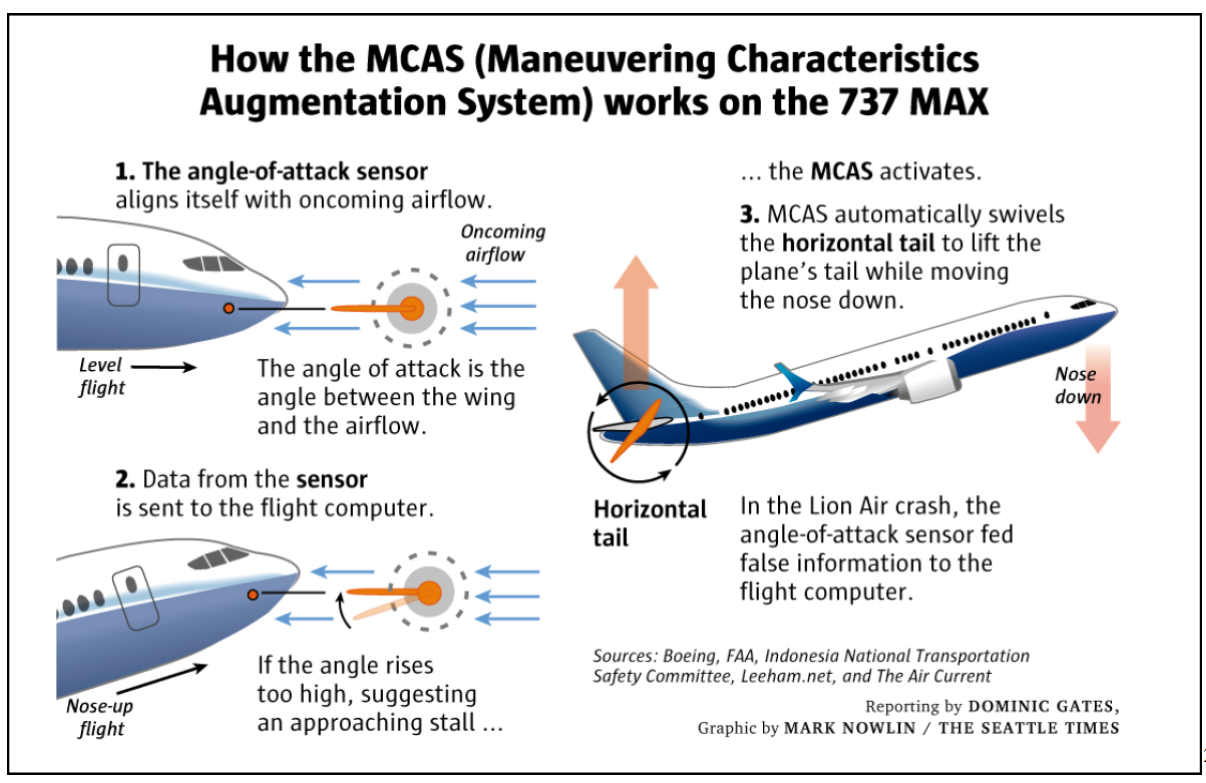
30. If the angle of attack sensors detect that the plane is pitching too high, the MCAS automatically adjusts the tail’s stabilizer—the horizontal part of the tail—to level out the plane. In other words, the MCAS activates automatically (i.e., without the input of the pilot) to push the plane’s nose down.
31. Rather than rely on multiple sensors, the 737 MAX 8 relies only on the angle of attack sensors. However, if the angle of attack sensors feed faulty or contradictory data to the MCAS, the system can force the aircraft into an unwarranted dive.
2 See https://www.seattletimes.com/business/boeing-aerospace/failed-certification-faa-missed-safety-issues-in-the-737-max-system-implicated-in-the-lion-air-crash/.
32. An undesired and unwarranted dive, of course, is never safe. But at low altitudes, the problem is particularly dangerous because it makes it far less likely that pilots can fix the problem and recover from the steep dive before crashing.
33. Electric trim control on the yoke may temporarily stop the MCAS-driven stabilizer movement. But the MCAS will activate again within a few seconds—forcing the nose down again—after the switches are released if the angle of attack is still sensed too high.
34. Early on in the certification of the 737 MAX, the FAA safety engineering team divided up the technical assessments that would be delegated to Boeing versus those that would be retained within the FAA. But, as certification proceeded, FAA managers urged its technical experts to speed up the process. Development of the MAX was lagging nine months behind the rival Airbus A320neo. Time was of the essence for Boeing. So, throughout the certification process, FAA technical experts were pressured by their superiors to delegate more and more authority to Boeing. In this atmosphere, the “System Safety Analysis” on the MCAS was delegated to Boeing.
35. Boeing engineers authorized to work on behalf of the FAA developed the System Safety Analysis for the MCAS, a document which, in turn, was shared with foreign air safety regulators in Europe, Canada, and elsewhere in the world. The document contains several flaws.
36. Boeing’s original System Safety Analysis of the MCAS understated the power of the MCAS, which was designed to swivel the horizontal tail to push the nose of the plane down to avert a stall. When the planes later entered service, it became clear that the MCAS was capable of moving the tail more than four times farther than was stated in the original safety analysis document. Specifically, the limit to how much the system could move the tail turned out to be 2.5 degrees, rather than a 0.6 degree limit as set out in the description Boeing provided to the FAA.
37. Boeing knew that the limit was higher than that specified in the original safety analysis document before the subject aircraft entered service. Safety analyses are required to be updated to reflect the most accurate aircraft information following flight tests. The numbers should match whatever design was tested and fielded, but Boeing’s final safety analysis was not updated to reflect the accurate limit and still contained the 0.6 limit.
38. The System Safety Analysis also failed to account for how the system could reset itself each time a pilot responded, thereby missing the potential impact of the system repeatedly pushing the airplane’s nose downward. In other words, the 2.5-degree limit applies each time MCAS is triggered, and it can be triggered multiple times, compounding the power of the MCAS to send the plane into an unrecoverable dive. Every time pilots reset the switches on their control columns to pull the nose back up, MCAS would have kicked in again, allowing new increments of 2.5 degrees until the stabilizer was moved to a position that would cause the maximum possible push downward. At a limit of 2.5 degrees, two cycles of MCAS without correction would have been enough to reach the maximum nose-down effect. Put simply, the MCAS had unlimited authority to push the plane’s nose down.
39. The System Safety Analysis was also flawed in the way it assessed a potential failure of the MCAS system. As explained above, the MCAS relied on only one sensor system—the angle of attack sensor—to determine whether to activate. Whether a system on a jet can rely on one sensor input, or must have two, is driven by the failure classification system in the system safety analysis. Virtually all equipment on any commercial airplane, including the various sensors, is reliable enough to meet the “major failure” requirement, meaning that it could cause physical distress to people on the plane, but not death, and that the probability of a failure is less than one in 100,000. Such systems are therefore typically allowed to rely on a single input sensor. But when Case: 1:19-cv-01924 Document #: 1 Filed: 03/20/19 Page 8 of 28 PageID #:
the consequences are assessed to be more severe—either “hazardous failures” causing serious or fatal injuries to a small number of passengers or “catastrophic failures” causing the loss of the plane with multiple fatalities—a system must have multiple input channels in case one goes wrong.
40. Boeing’s System Safety Analyses assessed an MCAS failure as either a “major failure” or, sometimes, a “hazardous failure,” in cases where the plane is in an extreme maneuver. Boeing knew or should have known that the failure to classify the MCAS’s failure as catastrophic, and thereby include the necessary checks and redundancies, was likely to lead to injuries and deaths. Moreover, the MCAS did not even meet the requirements for a system with a hazardous failure rating. Despite the MCAS’s assessment as a hazardous failure, it depended on the reading from a single angle-of-attack sensor (i.e., without any redundant input or check). Boeing could have designed the system to compare the readings from two angle-of-attack vanes, which would have indicated if one of them was faulty, but instead, the MCAS was designed to take a reading from only one of them. Alternatively, the system could have been designed to check that the angle-of-attack reading was accurate while the plane was taxiing on the ground before takeoff, when the angle of attack should read zero. But Boeing did not design or integrate these measures to ensure the MCAS would only activate in response to an accurate reading.
41. On the date of the subject accident, Boeing had not included a description of the MCAS in the flight crew operations manual (FCOM), which governs the master description of the aircraft for pilots. In other words, Boeing did not even notify pilots that the MCAS was operating on the MAX. It did not warn pilots that in certain circumstances it might cause the airplane to pitch down or force the airplane into a cycle of repeated dives. Nor did Boeing provide pilots with information about how to react to an MCAS that is forcing unwarranted and/or repeated dives.
42. Boeing’s stance that the pilots did not need to know about the MCAS or be trained to use the new system allowed the MAX to earn a common “type rating” with existing 737 models, allowing airlines to minimize training of pilots moving from previous generations of the 737 series to the MAX. Minimizing MAX pilot transition training was an important cost saving for Boeing’s airline customers, a key selling point for the jet.
The defective design, inadequate warning, and unreasonably dangerous conditions
43. At the time the subject aircraft left the custody and control of Boeing, at which point it entered the stream of commerce, and by and through the actions or omissions of Boeing, the subject aircraft was defective in design, had inadequate warnings, and was unreasonably dangerous in the following ways, among others:
a. the subject aircraft’s automated flight control system, which is new and unique to the 737 MAX series, causes the aircraft to dive down automatically towards the ground in situations where such dives are unwarranted, unreasonably dangerous, and erroneous;
b. the subject aircraft’s electrical and computer components erroneously and automatically force the nose of the airplane down, causing it to dive, even when the aircraft is being flown manually by pilots;
c. the subject aircraft’s flight control system incorrectly and automatically operates the aircraft in such a way as to cause excessive nose-down inputs and significant altitude loss;
d. the subject aircraft’s sensors are defective and generate false readings, including false readings related to the aircraft’s angle of attack—the angle between the wing and the oncoming airflow—which triggers the aircraft’s automated flight management and control systems to push the aircraft’s nose downward;
e. the subject aircraft’s lack of redundancies in its sensors renders it unreasonably dangerous because minor inputs and minor errors can force the aircraft into an uncontrollable nosedive;
f. the subject aircraft’s defective sensors and flight control system cause the aircraft’s control yolk to feel different from the yolks used for training the users of the 737 series, which cause the subject aircraft’s pilots to be confused and unable to correct the subject aircraft’s automatic dive;
g. Boeing failed to warn the airlines, pilots, users, and intended third-party beneficiaries of the defective automation that causes the subject aircraft to dive, Boeing failed to warn of the defective sensors, and Boeing failed to warn and educate users on possible manual overrides to the subject aircraft’s defective system; and
h. Boeing failed to adequately test the subject aircraft, its flight control system, and its sensors, and Boeing failed to substantiate the changes to its previous 737 models with sufficient testing and data.
44. At all relevant times, Boeing failed to warn the public, the airlines, the pilots, the users, and the intended third-party beneficiaries of the 737 MAX 8’s unreasonably dangerous and defective design, including that the aircraft automatically and uncontrollably dives.
45. At all relevant times, the subject aircraft failed to perform in a manner reasonably expected given its nature and intended purpose, as alleged herein.
46. The subject aircraft was not reasonably safe as designed. At the time of its manufacture, the likelihood that the subject aircraft would cause injury or death to passengers aboard the subject aircraft, including the Decedent, and considering the seriousness of the harm, outweighed the burden on Boeing of designing the subject aircraft in a way that would have prevented those harms, including the burden of issuing adequate warnings of such defects.
Pilots in the United States warned the FAA about Boeing 737 MAX 8 safety flaw
47. Pilots flying the Boeing 737 MAX 8 have repeatedly voiced safety concerns about the aircraft to federal authorities in the United States. The pilots’ complaints are available in a federal database where pilots can voluntarily report about aviation incidents without disclosing their name or employer.3
3 See https://www.dallasnews.com/business/airlines/2019/03/12/boeing-737-max-8-pilots-complained-feds-months-suspected-safety-flaw.
48. In October 2018, a Boeing 737 MAX 8 captain reported that the autothrottles on the aircraft failed to move to the commanded position after takeoff and climb. The pilot explained that after the aircraft had climbed to 1000 feet, he or she noticed a decrease in aircraft performance. The plane failed to climb, even though the autothrottles were engaged, and the pilot resolved the issue by manually positioning the thrust levers:
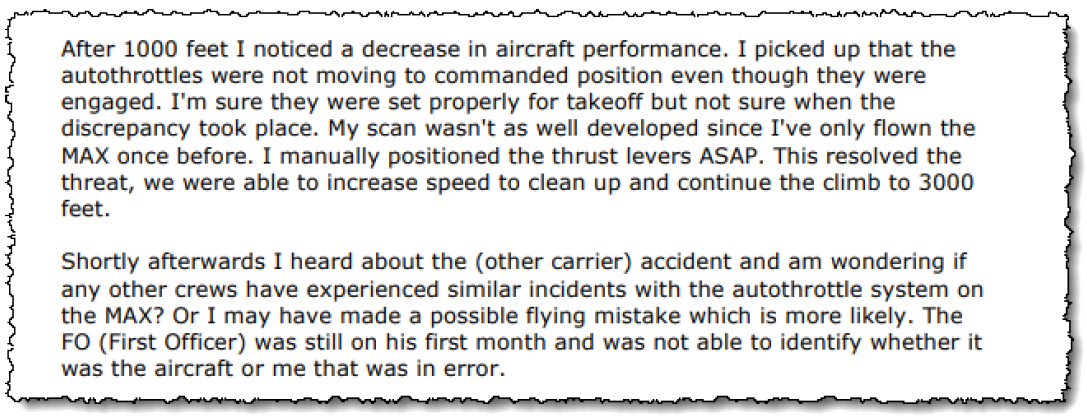
49. In November 2018, another Boeing 737 MAX 8 captain expressed frustration that some systems, including the MCAS (Maneuvering Characteristics Augmentation System) are not fully described in the Flight Manual for the Boeing 737 MAX 8, which the pilot described as “inadequate and almost criminally insufficient.” The pilot complained that it was “unconscionable” that Boeing and the FAA allowed pilots to fly the planes without adequate training or fully disclosing the information about how its systems were different from those on previous 737 models:
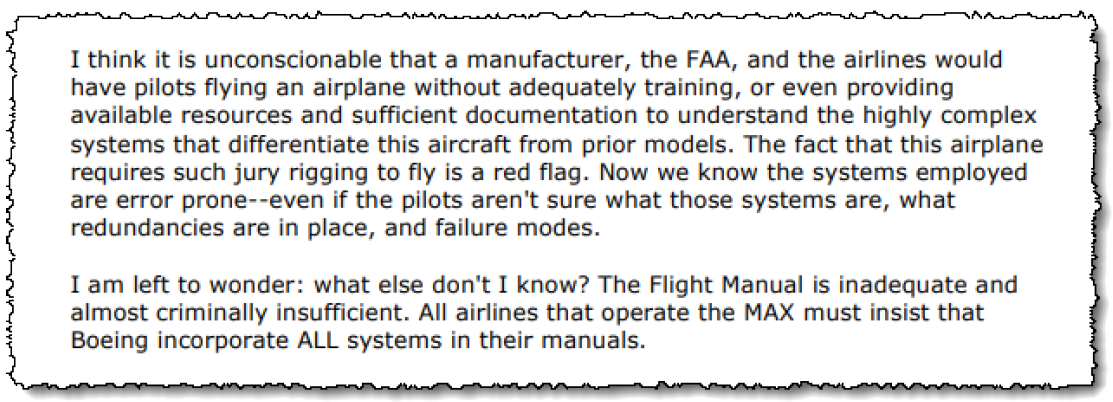
50. In November 2018, a Boeing 737 MAX 8 first officer reported an altitude deviation due to an intermediate level off by the aircraft auto-pilot system. The flight crew was forced to intervene, but because of the delay in achieving the correct altitude, Air Traffic Control issued brief off-course vectors to the pilots and other aircraft in the area.
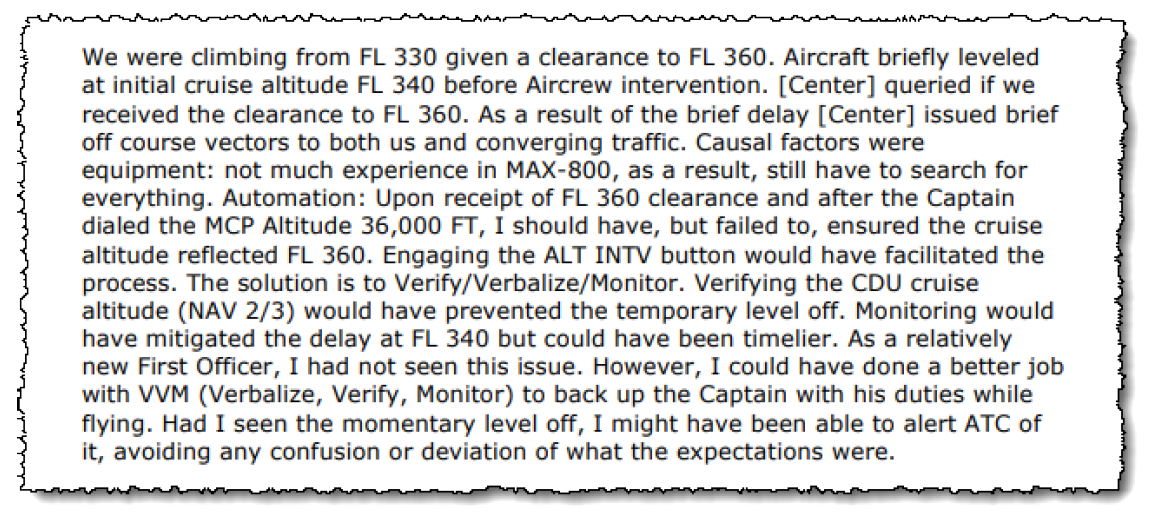
51. The same month, another Boeing 737 MAX 8 first officer reported that the aircraft had pitched nose down after the autopilot was engaged on departure. The GPWS (Ground Proximity Warning System)—the system designed to alert pilots if their aircraft is in immediate danger of flying into the ground or an obstacle—sounded, warning the pilots with the alert, “don’t sink, don’t sink.” The captain was able to avoid catastrophe by immediately disconnecting the autopilot and pitching the aircraft into a climb. The first officer wrote that he could not “think of any reason the aircraft would pitch nose down so aggressively”:
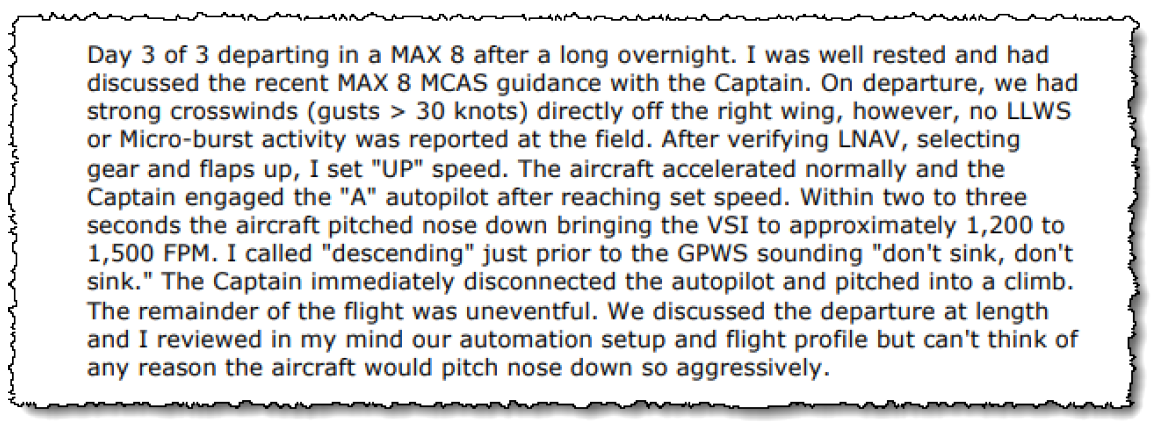
52. In November 2018, yet another Boeing 737 MAX 8 pilot reported an autopilot issue with the aircraft, which led to an undesired nose down situation shortly after takeoff. The GPWS sounded, warning the pilots that they were in immediate danger of flying into the ground, but the pilot was able to save the aircraft by disengaging the autopilot:
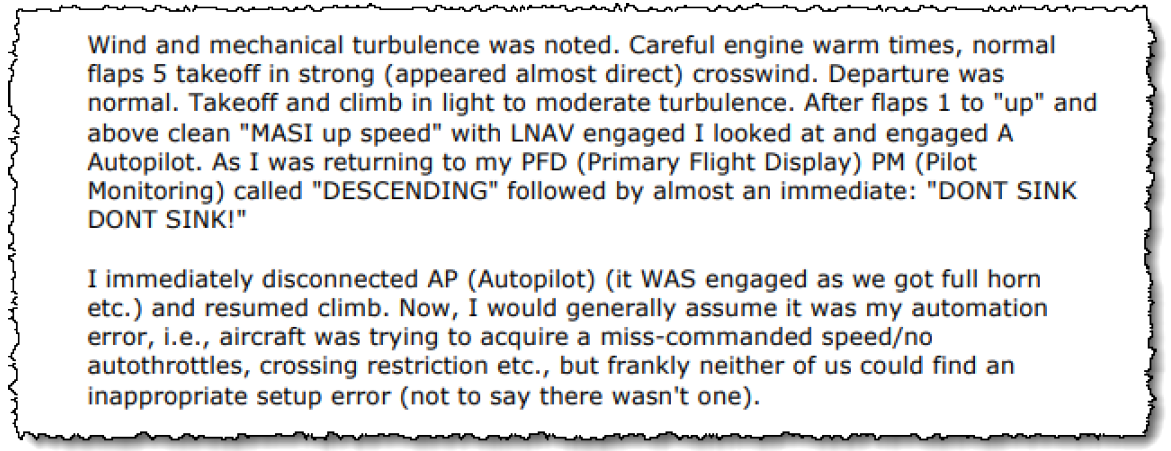
53. In an interview with the New York Times, Dennis Tajer, a pilot and spokesperson for the Allied Pilots Association, explained, “An aircraft dipping after takeoff is not normal. It’s beyond abnormal. It’s unacceptable.”4
44 See https://www.nytimes.com/interactive/2018/12/26/world/asia/lion-air-crash-12-minutes.html.
Lion Air Flight 610
54. On the morning of October 29, 2018, Lion Air was operating the subject aircraft on a scheduled passenger flight from Jakarta, Indonesia, to Pangkal Pinang, Indonesia.
55. As the aircraft climbed, the pilots could not determine the correct altitude or airspeed, asking air traffic control for help. Two critical sensors on the aircraft registered different readings between the pilot and co-pilot.
56. Then, the plane dropped over 700 feet, furthering the confusion inside the cockpit. The aircraft’s computer system had forced the plane’s nose down. The pilots recovered from the drop, but air traffic control noted the pilots were experiencing a flight control problem.
57. Outside the plane, one of the aircraft’s angle of attack sensors falsely indicated that the plane’s nose was pointed too high, and that the aircraft could stall.
58. Upon information and belief, this false angle of attack reading triggered the automatic MCAS, which pushed up the forward edge of the stabilizers on the plane’s tail and forced the plane’s nose down. The pilots responded by moving the stabilizers in the opposite direction, trying to lift the plane’s nose back up. This created a tug of war between the plane and the pilots—nose down, nose up—that seesawed the aircraft more than two dozen times.
59. In their fight against the 737 MAX 8’s automatic system, the pilots repeatedly held down the electric stabilizer trim switch to bring the plane’s nose up. But it was only a temporary fix, and after a few seconds, the automatic system kicked back in, forcing the nose back down.
60. In the final minute of the flight, things became frantic. The co-pilot told air traffic control that they needed to turn the plane back around and that the aircraft instruments were feeding the pilots inconsistent information.
61. The pilots were losing their fight against the automatic system. They pulled desperately on the control columns in a last-ditch effort to level the plane, but it was too late. Approximately twelve minutes after takeoff, the subject aircraft plunged 5,000 feet at 450 miles per hour and crashed into the Java Sea, killing everyone on board.
62. The following graph provided by the website flightaware.com illustrates how the flight’s altitude during takeoff differed from what would have been expected in a normal takeoff, fluctuating wildly throughout the 12 minutes before crashing:
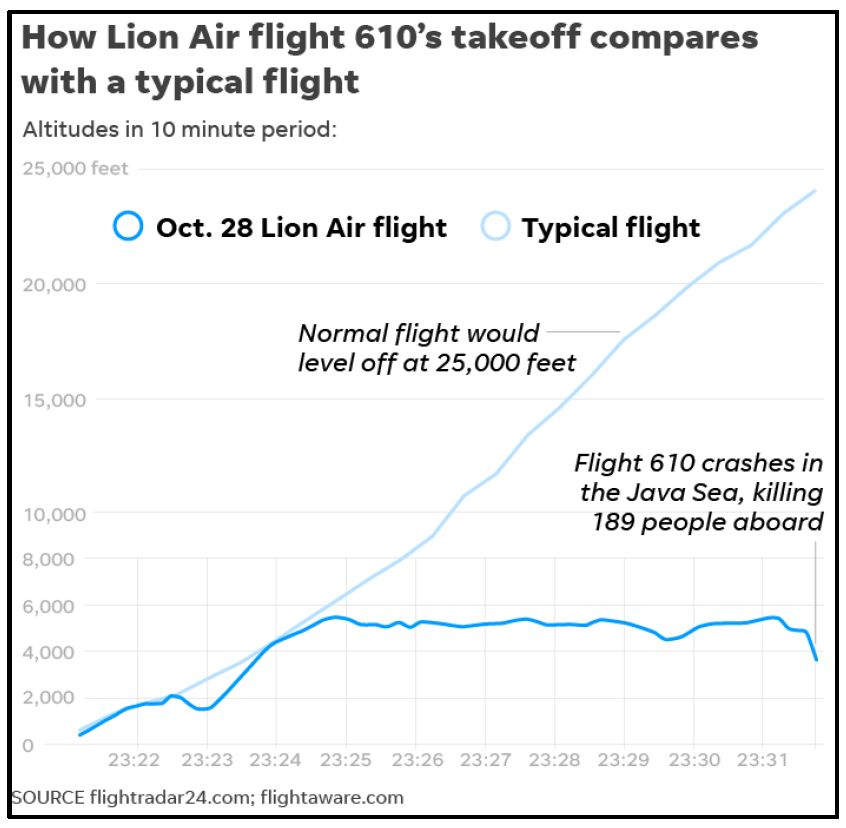
63. The Decedent was on board the subject flight.
64. As a direct and proximate result of the defects alleged herein, the subject aircraft crashed and killed the Decedent.
65. The original Boeing document provided to the FAA included a description specifying a limit to how much the system could move the horizontal tail—a limit of 0.6 degrees, out of a physical maximum of just less than 5 degrees of nose-down movement. The limit was later increased after flight tests showed that a more powerful movement of the tail was required to avert a high-speed stall, when the plane is in danger of losing lift and spiraling down. After the subject accident, Boeing for the first time provided to airlines details about the MCAS. Boeing’s bulletin to the airlines stated that the limit of MCAS’s command was 2.5 degrees. The number was apparently new to FAA engineers who had seen 0.6 degrees in their safety assessment. The higher limit meant that each time MCAS was triggered, it caused a much greater movement of the tail than was specified in the original safety analysis document.
66. The subject accident also demonstrated that the MCAS can be triggered multiple times, and because the MCAS reset each time it was used, it effectively had unlimited authority to give the airplane’s nose the maximum possible push downward. At a limit of 2.5 degrees, two cycles of MCAS without correction would have been enough to reach the maximum nose-down effect.
67. Following the subject accident, the FAA issued “Emergency Airworthiness Directive (AD) 2018-23-51” to the “owners and operators of The Boeing Company Model 737-8 and -9 airplanes,” which contained mandatory warnings and instructions regarding the “unsafe condition . . . likely to exist or develop” in the 737 MAX 8.
68. A few months later, on March 10, 2019, another brand-new Boeing 737 MAX 8, Ethiopian Airlines Flight 302, crashed mere minutes after leaving Ethiopia’s capital, killing all 157 people on board. Flight 302 took off in good weather, but its vertical speed became unstable right after takeoff, fluctuating wildly, according to data published by FlightRadar24, even though the aircraft should have sustained positive vertical speed indications during takeoff. Like the Case: 1:19-cv-01924 Document #: 1 Filed: 03/20/19 Page 17 of 28 PageID #:17
18 subject accident, the 737 Max 8 that crashed in Ethiopia experienced abnormal altitude fluctuations at takeoff—gaining altitude and then leveling out. Compare the following two graphs:
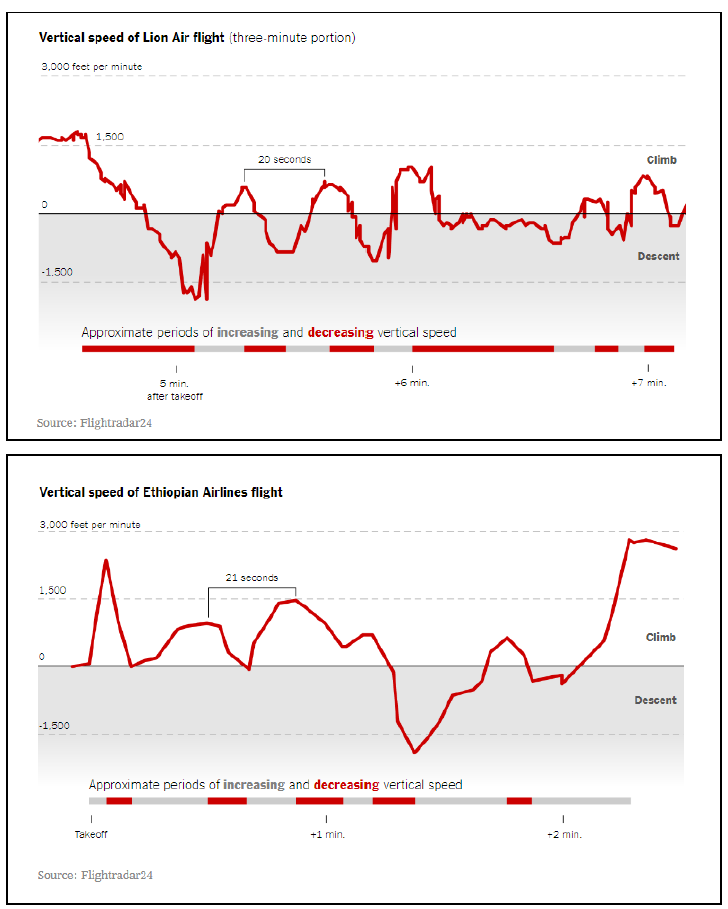
69. This preliminary data indicates that the two planes may have experienced the same malfunctioning automated system—an unwarranted activation of the MCAS.
70. In the days following the crash of Ethiopian Flight 302, and at the time of the filing of this Complaint, all countries have grounded Boeing 737 MAX 8 aircraft from continued flights.
CAUSES OF ACTION
COUNT I
STRICT PRODUCTS LIABILITY
71. The Plaintiffs re-adopt and re-allege paragraphs 1 through 70 above.
72. At all relevant times, the subject aircraft was sold and delivered by Boeing without being altered by some other party and without substantial change in the condition in which it was sold and delivered, and it was being used as intended by, or in a manner that was reasonably foreseeable to, Boeing.
73. At the time the subject aircraft left the custody and control of Boeing, at which point it entered the stream of commerce, and by and through the actions or omissions of Boeing, the subject aircraft was defective in design, had inadequate warnings, and was unreasonably dangerous in the following ways, among others:
a. the subject aircraft’s automated flight control system, which is new and unique to the 737 MAX series, causes the aircraft to dive down automatically towards the ground in situations where such dives are unwarranted, unreasonably dangerous, and erroneous;
b. the subject aircraft’s electrical and computer components erroneously and automatically force the nose of the airplane down, causing it to dive, even when the aircraft is being flown manually by pilots;
c. the subject aircraft’s flight control system incorrectly and automatically operates the aircraft in such a way as to cause excessive nose-down inputs and significant altitude loss;
d. the subject aircraft’s sensors are defective and generate false readings, including false readings related to the aircraft’s angle of attack—the angle between the
Case: 1:19-cv-01924 Document #: 1 Filed: 03/20/19 Page 19 of 28 PageID #:19
20
wing and the oncoming airflow—which triggers the aircraft’s automated flight management and control systems to push the aircraft’s nose downward;
e. the subject aircraft’s lack of redundancies in its sensors renders it unreasonably dangerous because minor inputs and minor errors can force the aircraft into an uncontrollable nosedive;
f. the subject aircraft’s defective sensors and flight control system cause the aircraft’s control yolk to feel different from the yolks used for training the users of the 737 series, which cause the subject aircraft’s pilots to be confused and unable to correct the subject aircraft’s automatic dive;
g. Boeing failed to warn the airlines, pilots, users, and intended third-party beneficiaries of the defective automation that causes the subject aircraft to dive, Boeing failed to warn of the defective sensors, and Boeing failed to warn and educate users on possible manual overrides to the subject aircraft’s defective system; and
h. Boeing failed to adequately test the subject aircraft, its flight control system, and its sensors, and Boeing failed to substantiate the changes to its previous 737 models with sufficient testing and data.
74. At all relevant times, Boeing failed to warn the public, the airlines, the pilots, the users, and the intended third-party beneficiaries of the 737 MAX 8’s unreasonably dangerous and defective design, including that the aircraft automatically and uncontrollably dived partly because of erroneous sensors.
75. At all relevant times, the subject aircraft failed to perform in a manner reasonably expected given its nature and intended purpose, as alleged herein.
76. The subject aircraft was not reasonably safe as designed. At the time of its manufacture, the likelihood that the subject aircraft would cause injury or death to passengers aboard the subject aircraft, including the Decedent, and considering the seriousness of the harm, outweighed the burden on Boeing of designing the subject aircraft in a way that would have prevented those harms, including the burden of issuing adequate warnings of such defects.
77. The defects in the design and warning of the subject aircraft caused the subject accident, which directly, proximately, and foreseeably caused the deaths of everyone aboard the subject aircraft, including the Decedent.
78. The Plaintiffs have been injured and thus claim all damages available to them, the estate, the survivors, the beneficiaries, and the heirs under applicable law, including pecuniary losses, loss of companionship, loss of guidance, loss of consortium, loss of advice, loss of society, and damages associated with grief, sorrow, and mental suffering, as well as pain and suffering and emotional distress.
WHEREFORE, the Plaintiffs, as Special Administrator of the Estate of the Decedent, and on behalf of the Decedent’s survivors, beneficiaries, and heirs, pray for judgment in their favor against Boeing for damages, costs, fees, and all other awards deemed just. The Plaintiffs further demands a trial by jury of all issues triable as of right by a jury.
COUNT II
NEGLIGENCE – PRODUCTS LIABILITY
79. The Plaintiffs re-adopt and re-allege paragraphs 1 through 70 above.
80. At all relevant times, Boeing owed a duty to use reasonable care, and to exercise the highest degree of care, in planning, designing, certifying, manufacturing, assembling, installing, overhauling, modifying, repairing, testing, inspecting, marketing, and distributing its aircraft, including the subject aircraft, and its component parts, so as to not cause injury to, or the death of, the subject aircraft’s passengers, including the Decedent, who would put the subject aircraft to its normal and intended use.
81. Boeing negligently breached the duty of care it owed to the Plaintiffs and the Decedent by negligently and carelessly designing the subject aircraft with unreasonably dangerous defects, by designing an unreasonably dangerous product that failed to perform in a manner reasonably to be expected in light of its nature and intended function, and by placing the subject aircraft into the stream of commerce with unreasonably dangerous design defects
82. At all relevant times, the subject aircraft was sold and delivered by Boeing without being altered by some other party and without substantial change in the condition in which it was sold and delivered, and it was being used as intended by, or in a manner that was reasonably foreseeable to, Boeing.
83. At the time the subject aircraft left the custody and control of Boeing, at which point it entered the stream of commerce, and by and through the negligent actions or omissions of Boeing, the subject aircraft was defective in design, had inadequate warnings, and was unreasonably dangerous in the following ways, among others:
a. the subject aircraft’s automated flight control system, which is new and unique to the 737 MAX series, causes the aircraft to dive down automatically towards the ground in situations where such dives are unwarranted, unreasonably dangerous, and erroneous;
b. the subject aircraft’s electrical and computer components erroneously and automatically force the nose of the airplane down, causing it to dive, even when the aircraft is being flown manually by pilots;
c. the subject aircraft’s flight control system incorrectly and automatically operates the aircraft in such a way as to cause excessive nose-down inputs and significant altitude loss;
d. the subject aircraft’s sensors are defective and generate false readings, including false readings related to the aircraft’s angle of attack—the angle between the wing and the oncoming airflow—which triggers the aircraft’s automated flight management and control systems to push the aircraft’s nose downward;
e. the subject aircraft’s lack of redundancies in its sensors renders it unreasonably dangerous because minor inputs and minor errors can force the aircraft into an uncontrollable nosedive;
f. the subject aircraft’s defective sensors and flight control system cause the aircraft’s control yolk to feel different from the yolks used for training the users of the 737 series, which cause the subject aircraft’s pilots to be confused and unable to correct the subject aircraft’s automatic dive; Case: 1:19-cv-01924 Document #: 1 Filed: 03/20/19 Page 22 of 28 PageID #:22
23
g. Boeing failed to warn the airlines, pilots, users, and intended third-party beneficiaries of the defective automation that causes the subject aircraft to dive, Boeing failed to warn of the defective sensors, and Boeing failed to warn and educate users on possible manual overrides to the subject aircraft’s defective system; and
h. Boeing failed to adequately test the subject aircraft, its flight control system, and its sensors, and Boeing failed to substantiate the changes to its previous 737 models with sufficient testing and data.
84. At all relevant times, Boeing negligently failed to warn the public, the airlines, the pilots, the users, and the intended third-party beneficiaries of the 737 MAX 8’s unreasonably dangerous and defective design, including that the aircraft automatically and uncontrollably dived partly because of erroneous sensors.
85. At all relevant times, the subject aircraft failed to perform in a manner reasonably expected given its nature and intended purpose, as alleged herein.
86. The subject aircraft was not reasonably safe as designed. At the time of its manufacture, the likelihood that the subject aircraft would cause injury or death to passengers aboard the subject aircraft, including the Decedent, and considering the seriousness of the harm, outweighed the burden on Boeing of designing the subject aircraft in a way that would have prevented those harms, including the burden of issuing adequate warnings of such defects.
87. The defects in the design and warning of the subject aircraft caused the subject accident, which directly, proximately, and foreseeably caused the deaths of everyone aboard the subject aircraft, including the Decedent.
88. The Plaintiffs have been injured and thus claim all damages available to them, the estate, the survivors, the beneficiaries, and the heirs under applicable law, including pecuniary losses, loss of companionship, loss of guidance, loss of consortium, loss of advice, loss of society, and damages associated with grief, sorrow, and mental suffering, as well as pain and suffering and emotional distress.
WHEREFORE, the Plaintiffs, as Special Administrator of the Estate of the Decedent, and on behalf of the Decedent’s survivors, beneficiaries, and heirs, pray for judgment in their favor against Boeing for damages, costs, fees, and all other awards deemed just. The Plaintiffs further demand a trial by jury of all issues triable as of right by a jury.
COUNT III
FAILURE TO WARN
89. The Plaintiffs re-adopt and re-allege paragraphs 1 through 70 above.
90. At all relevant times, Boeing owed a duty to use reasonable care, and to exercise the highest degree of care, in planning, designing, certifying, manufacturing, assembling, installing, overhauling, modifying, repairing, testing, inspecting, marketing, and distributing its aircraft, including the subject aircraft, and its component parts, so as to not cause injury to, or the death of, the subject aircraft’s passengers, including the Decedent, who would put the subject aircraft to its normal and intended use.
91. Boeing negligently breached the duty of care it owed to the Plaintiffs and the Decedent by negligently and carelessly designing the subject aircraft with unreasonably dangerous defects, by designing an unreasonably dangerous product that failed to perform in a manner reasonably to be expected in light of its nature and intended function, and by placing the subject aircraft into the stream of commerce with unreasonably dangerous design defects
92. At all relevant times, the subject aircraft was sold and delivered by Boeing without being altered by some other party and without substantial change in the condition in which it was sold and delivered, and it was being used as intended by, or in a manner that was reasonably foreseeable to, Boeing.
93. At the time the subject aircraft left the custody and control of Boeing, at which point it entered the stream of commerce, and by and through the negligent actions or omissions of
Boeing, the subject aircraft was defective in design, had inadequate warnings, and was unreasonably dangerous in the following ways, among others:
a. the subject aircraft’s automated flight control system, which is new and unique to the 737 MAX series, causes the aircraft to dive down automatically towards the ground in situations where such dives are unwarranted, unreasonably dangerous, and erroneous;
b. the subject aircraft’s electrical and computer components erroneously and automatically force the nose of the airplane down, causing it to dive, even when the aircraft is being flown manually by pilots;
c. the subject aircraft’s flight control system incorrectly and automatically operates the aircraft in such a way as to cause excessive nose-down inputs and significant altitude loss;
d. the subject aircraft’s sensors are defective and generate false readings, including false readings related to the aircraft’s angle of attack—the angle between the wing and the oncoming airflow—which triggers the aircraft’s automated flight management and control systems to push the aircraft’s nose downward;
e. the subject aircraft’s lack of redundancies in its sensors renders it unreasonably dangerous because minor inputs and minor errors can force the aircraft into an uncontrollable nosedive;
f. the subject aircraft’s defective sensors and flight control system cause the aircraft’s control yolk to feel different from the yolks used for training the users of the 737 series, which cause the subject aircraft’s pilots to be confused and unable to correct the subject aircraft’s automatic dive;
g. Boeing failed to warn the airlines, pilots, users, and intended third-party beneficiaries of the defective automation that causes the subject aircraft to dive, Boeing failed to warn of the defective sensors, and Boeing failed to warn and educate users on possible manual overrides to the subject aircraft’s defective system; and
h. Boeing failed to adequately test the subject aircraft, its flight control system, and its sensors, and Boeing failed to substantiate the changes to its previous 737 models with sufficient testing and data.
94. At all relevant times, Boeing negligently failed to warn the public, the airlines, the pilots, the users, and the intended third-party beneficiaries of the 737 MAX 8’s unreasonably dangerous and defective design, including that the aircraft automatically and uncontrollably dived partly because of erroneous sensors.
95. At all relevant times, the subject aircraft failed to perform in a manner reasonably expected given its nature and intended purpose, as alleged herein.
96. The subject aircraft was not reasonably safe as designed. At the time of its manufacture, the likelihood that the subject aircraft would cause injury or death to passengers aboard the subject aircraft, including the Decedent, and considering the seriousness of the harm, outweighed the burden on Boeing of designing the subject aircraft in a way that would have prevented those harms, including the burden of issuing adequate warnings of such defects.
97. The defects in the design and warning of the subject aircraft caused the subject accident, which directly, proximately, and foreseeably caused the deaths of everyone aboard the subject aircraft, including the Decedent.
98. The Plaintiffs have been injured and thus claim all damages available to them, the estate, the survivors, the beneficiaries, and the heirs under applicable law, including pecuniary losses, loss of companionship, loss of guidance, loss of consortium, loss of advice, loss of society, and damages associated with grief, sorrow, and mental suffering, as well as pain and suffering and emotional distress.
WHEREFORE, the Plaintiffs, as Special Administrator of the Estate of the Decedent, and on behalf of the Decedent’s survivors, beneficiaries, and heirs, pray for judgment in their favor against Boeing for damages, costs, fees, and all other awards deemed just. The Plaintiffs further demand a trial by jury of all issues triable as of right by a jury.
COUNT IV
CIVIL CONSPIRACY
99. The Plaintiffs re-adopt and re-allege paragraphs 1 through 70 above.
100. Boeing conspired with and assented to a scheme, device, plan, and agreement with other entities and individuals, including the FAA and/or personnel delegated authority by the FAA, to certify the Boeing 737 MAX series in violation of the laws and regulations of the United States for the purpose of speeding up the approval process of the Boeing 737 MAX series, which in turn gave Boeing a financial and competitive advantage in the aviation industry.
101. Boeing and these other entities and individuals engaged in concerted actions to conceal, deny, and downplay the hazards and safety concerns, in violation of federal regulations, presented by the Boeing 737 MAX 8’s new features, including its MCAS, heavier and repositioned engines, and unstable aerodynamics.
102. Boeing took overt tortious and/or unlawful actions in furtherance of the conspiracy, including by failing to correctly classify the safety concerns presented by the MCAS; by failing to adhere to industry standards and regulations in designing and testing the 737 MAX; by failing to recuse itself from the certification process when it knew or should have known that it was acting under tremendous financial pressure to certify the 737 MAX promptly; and by applying pressure, whether directly or indirectly, to the Boeing personnel that had been delegated regulatory authority to certify the 737 MAX without appropriate testing and data, and in a rushed manner,
103. As a direct and proximate result of this conspiracy, the Plaintiffs have been harmed, and hereby claim all damages available under applicable law.
WHEREFORE, the Plaintiffs, as Special Administrator of the Estate of the Decedent, and on behalf of the Decedent’s survivors, beneficiaries, and heirs, pray for judgment in their favor against Boeing for damages, costs, fees, and all other awards deemed just. The Plaintiffs further demand a trial by jury of all issues triable as of right by a jury.
JURY TRIAL
The Plaintiffs demand a jury trial.
Dated: March 20, 2019
Case: 1:19-cv-01924 Document #: 1 Filed: 03/20/19 Page 27 of 28 PageID #:27
28
Respectfully Submitted,
PODHURST ORSECK, P.A.
SunTrust International Center, Suite 2300
One S.E. Third Avenue
Miami, Florida 33131
(305) 358-2800 / Fax (305) 358-2382
/s/ Steven C. Marks___________
Steven C. Marks
Fla. Bar No. 516414
Kristina M. Infante
Fla. Bar. No. 112557
To be admitted Pro Hac Vice
Steven C. Marks
Kristina M. Infante
PODHURST ORSECK, P.A.
SunTrust International Center, Suite 2300
One S.E. Third Avenue
Miami, Florida 33131
(305) 358-2800 / Fax (305) 358-2382
Local Counsel
Andrew T. Hays
Sarah Buck
HAYS FIRM LLC
55 W. Wacker Drive, 14th Floor
Chicago, IL 60602
(312) 626-2537
ahays@haysfirm.com





